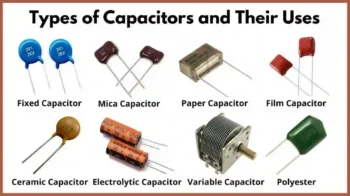Which One is Right for Your Extend?
Choosing the correct capacitor is basic for guaranteeing the ideal execution of your electronic plans. Two of the foremost broadly utilized capacitor types—electrolytic and ceramic capacitors—offer particular points of interest, making them reasonable for distinctive applications. In this web journal, we’ll compare these two components over key measurements, such as capacitance, voltage tolerance, size, taken a toll, and utilize cases. This direct will assist you decide the perfect choice for your another extend.
What Are Electrolytic Capacitors?
Electrolytic capacitors are polarized components that offer tall capacitance in a little bundle. They comprise of a metal anode (ordinarily aluminum or tantalum), a fluid or strong electrolyte, and a lean oxide film acting as the dielectric. Due to their huge capacitance-to-size proportion, they are commonly utilized in DC circuits where noteworthy vitality capacity is required. Be that as it may, they are unacceptable for AC applications as switching extremity can lead to harm.

Key Applications of Electrolytic Cap:
Control Supplies:
Channel voltage swells in DC circuits.
Sound Circuits:
Oversee the vitality needs of enhancers.
DC-DC Converters:
Control yield voltage.
Vitality Capacity Frameworks:
Give control bursts in gadgets like cameras.
What Are Ceramic Capacitors?
Ceramic capacitors are non-polarized components, which makes them reasonable for both AC and DC circuits. They are made from layers of ceramic fabric that act as the dielectric, with metal anodes in between. These capacitors are esteemed for their soundness and compact measure, making them perfect for high-frequency applications.
Key Applications:
High-Frequency Circuits:
Channel out high-frequency commotion in radios and RF gear.
IoT Gadgets:
Stabilize microcontroller operations.
Shopper Gadgets:
Found in smartphones, tablets, and other convenient gadgets.
Car Gadgets:
Utilized in motor control units and infotainment frameworks.
Electrolytic vs. Ceramic Capacitor
Let’s jump into the contrasts between these two sorts to assist you select the correct one for your needs.
-
Capacitance and Vitality Capacity
Electrolytic Capacitors:
Give tall capacitance, frequently extending from microfarads (μF) to millifarads (mF). Perfect for control sifting and vitality capacity applications.
Ceramic Capacitors:
Offer littler capacitance values, regularly extending from picofarads (pF) to microfarads. Way better suited for high-frequency sifting and flag decoupling.
Champ:
Electrolytic capacitors for bulk vitality capacity; ceramic capacitors for high-frequency circuits. -
Voltage Resistance and Extremity
Electrolytic Capacitors:
Have lower voltage evaluations and must be associated with redress extremity to avoid disappointment.
Ceramic Capacitors:
Highlight higher voltage evaluations and can endure both AC and DC voltages, making them more flexible. -
Measure and Space Necessities
Electrolytic Capacitors:
Bulkier, in spite of the fact that they give more vitality capacity in compact shape compared to other high-capacitance components.
Ceramic Capacitors:
Amazingly little and accessible in surface-mount bundles, perfect for space-constrained applications like wearables and smartphones.
Victor:
Ceramic capacitors for compact plans. -
Fetched Comparison
Electrolytic Capacitors:
More reasonable for applications requiring tall capacitance, with costs extending from $0.10 to $2.00, depending on the estimate and brand.
Ceramic Capacitors:
Whereas by and large reasonable, high-quality multilayer ceramic capacitors (MLCCs) can fetched somewhat more due to supply chain disturbances and rising request.
Victor:
Both sorts are cost-effective, depending on the particular extend needs. -
Life expectancy and Unwavering quality
Electrolytic Capacitors:
Have a constrained life expectancy due to the debasement of the electrolyte, particularly in high-temperature situations.
Ceramic Capacitors:
Offer longer life expectancies and prevalent solidness over a wide extend of temperatures, making them dependable over time.
Champ:
Ceramic capacitors for life span and unwavering quality.
When to Select Electrolytic Capacitors
Electrolytic capacitors exceed expectations in applications where huge vitality capacity is required. Here are a few perfect utilize cases:
Control Supply Units (PSUs):
Smooth out DC voltage swells.
Sound Frameworks:
Store vitality for energetic sound yield.
DC Engines:
Stabilize voltage amid control surges.
Mechanical Frameworks:
Oversee control in car and control circuits.
When to Select Ceramic Capacitors
Ceramic capacitors are the go-to choice for high-frequency sifting and compact plans. A few perfect utilize cases incorporate:
IoT Gadgets:
Keep up steady sensor operations.
High-Frequency Circuits:
Channel clamor in RF circuits.
Buyer Hardware:
Decouple signals in smartphones and portable workstations.
Car Frameworks:
Channel clamor in motor control units and infotainment frameworks.
Estimating Patterns:
Electrolytic vs. Ceramic Capacitors
The fetched of electrolytic and ceramic capacitors shifts based on variables such as measure, materials, and advertise request.
Electrolytic Capacitors:
Costs stay steady but are impacted by the fetched of aluminum and tantalum. Standard capacitors fetched 0.10 to 2.00 Rupees each.
Ceramic Capacitors:
Costs can vacillate due to supply chain disturbances. Straightforward capacitors taken a toll 0.05, whereas high-end MLCCs can reach 1.50 Rupees or more.
Conclusion:
Which Capacitor Ought to You Select?
The choice between electrolytic and ceramic capacitors depends on the particular needs of your venture. Utilize electrolytic capacitors for power-intensive applications, such as control supplies, sound frameworks, and mechanical frameworks. On the other hand, ceramic capacitors are perfect for high-frequency, compact plans, counting IoT gadgets, smartphones, and car gadgets.
At ElectroGlobal, we offer a wide selection of both electrolytic and ceramic capacitors to meet the demands of any project. Browse our catalog today to find the perfect component for your next design.





